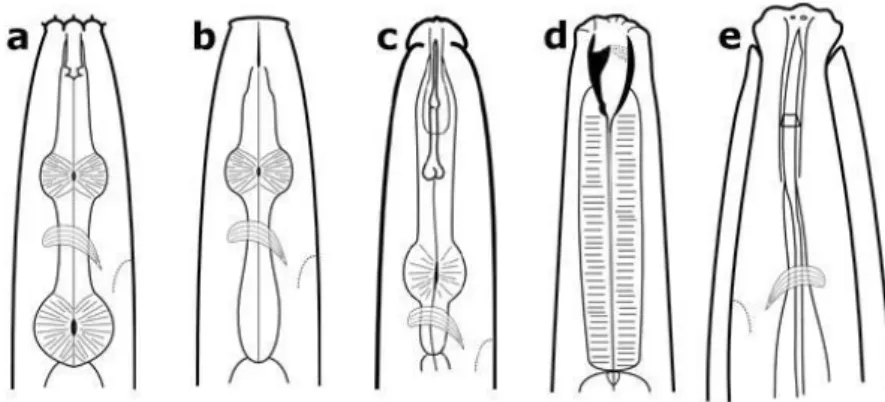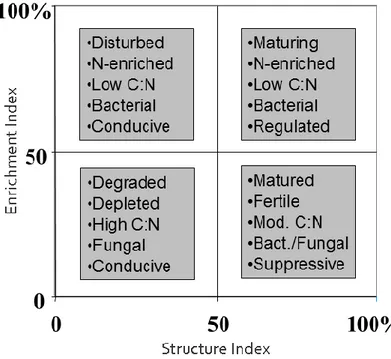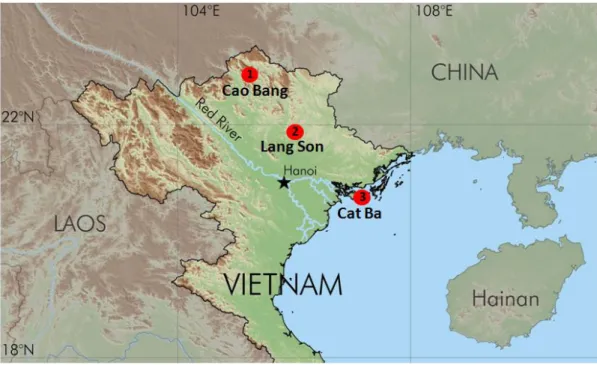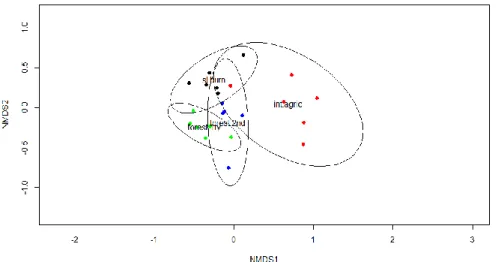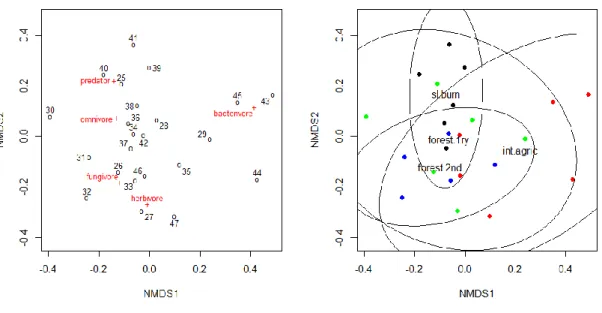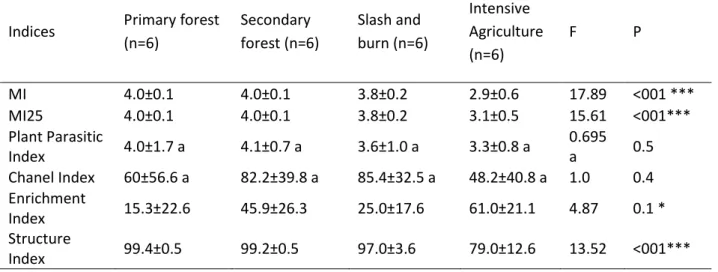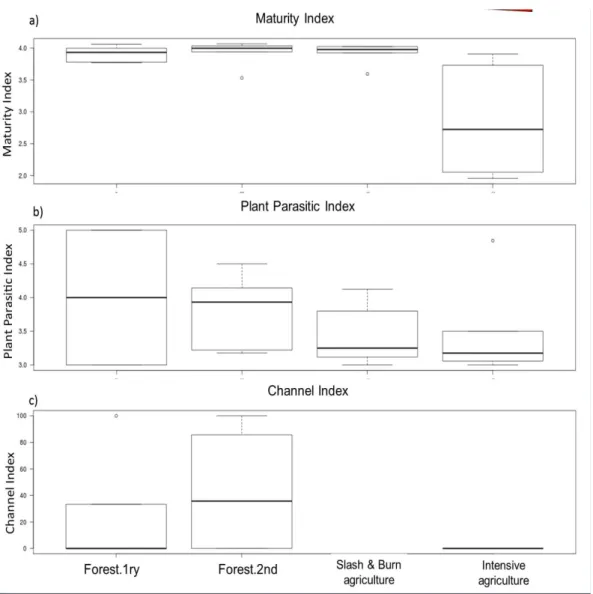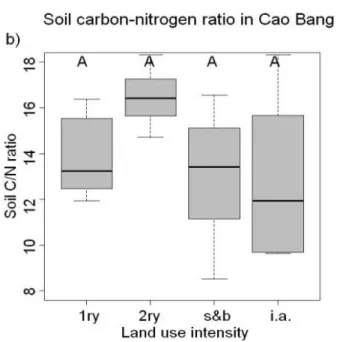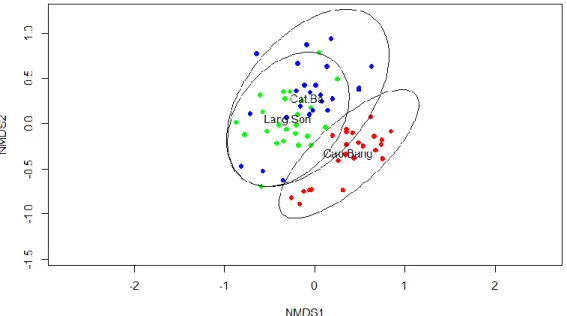Community structure and ecological niches of free-living terrestrial nematodes in
north-eastern Vietnam
I n a u g u r a l – D i s s e r t a t i o n
zur
Erlangung des Doktorgrades
der Mathematisch-Naturwissenschaflichen Fakultät der Universität zu Köln
vorgelegt von
Thi Anh Duong Nguyen
aus Hanoi, Vietnam
Köln 2017
Community structure and ecological niches of free-living terrestrial nematodes in north-eastern Vietnam
2
Berichterstatter:
Prof. Dr. Michael Bonkowski PD. Dr. Thomas Ziegler
Vorsitz der Prüfung:
Prof. Dr. Frank Schäbitz
Beisitzerin:
Dr. Alexandra Jeuck
Tag der letzten mündlichen Prüfung: 19. 01. 2017
„Gedruckt mit Unterstützung des Deutschen Akademischen Austauschdienstes“
Community structure and ecological niches of free-living terrestrial nematodes in north-eastern Vietnam
3 Contents
1.1 Nematodes and their role in the environment ... 9
1.1.1 Nematodes as a zoological group ... 9
1.1.2 Nematodes as key organisms of the soil food web... 9
1.1.3 The nematode order Dorylaimida ... 12
1.1.4 A brief historical outline of nematological studies in Vietnam ... 13
1.2 The Vietnamese landscape ... 14
1.2.1 Geography and climate ... 14
1.2.2 Biodiversity ... 15
1.2.3 Land use intensity (anthropogenic impact) ... 15
1.3 Nematode community analysis ... 16
2. Material and methods ... 20
2.1 Study areas ... 20
2.2 Soil sampling ... 21
2.3 Soil analysis ... 22
2.4 Extraction, processing and mounting of nematodes ... 22
2.5 Morphological characterization of nematodes: LM and SEM ... 23
2.6 Molecular analysis of nematodes ... 24
2.7 Statistical analysis ... 25
3. Publications ... 26
Publication 1 ... 26
Publication 2 ... 42
Publication 3 ... 64
Publication 4 ... 85
Publication 5 ... 106
Publication 6 ... 115
Publication 7 ... 127
Publication 8 ... 137
Publication 9 ... 143
4. Discussion ... 164
4.1 Species richness of free-living nematodes in tropical forest ... 164
4.2 Impact of land use intensity on nematode communities ... 168
4.3 The relationships of nematode community composition and soil C/N ratio ... 173
5. References... 174
Community structure and ecological niches of free-living terrestrial nematodes in north-eastern Vietnam
4
6. Appendix ... 186
7. Acknowledgements ... 191
8. Declaration of Contribution as Author and Co-Author ... 193
9. Erklärung ... 199
10. Curriculum Vitae ... 202
Community structure and ecological niches of free-living terrestrial nematodes in north-eastern Vietnam
5
Zusammenfassung
Nematoden sind hochabundant und global die diverseste Gruppe der Bodenfauna. Es gibt nur wenige Taxonomen für freilebende Nematoden und daher existieren weltweit nur eine Handvoll Studien zu freilebenden Nematoden aus tropischen Gebieten. Der Artenreichtum und die funktionelle Zusammensetzung von Nematodengemeinschaften In Vietnam sind noch vollständig unbekannt. Veränderungen von Bodenfunktionen beeinflussen Nematodengemeinschaften lange bevor chemische und physikalische Bodenparameter messbar sind. Daher sind Nematoden exzellente Indikatoren von Bodenfunktionen und Ökosystemdienstleistungen.
Wir untersuchten die Nematodenfauna in Böden dreier Naturreservate in den Provinzen Cao Bang, Lang Son und Cat Ba Provinces im Nordosten Vietnams im May 2013. Nematoden wurden (wenn möglich) auf auf Artniveau bestimmt um die Zahl und Diversität der bekannten und unbekannten Taxa zu bestimmen. Basierend auf den trophischen Gruppen wurden die Nematoden anschließend funktionelle Gilden zugeordnet. Mit diesen Daten wurden unterschiedliche ökologische Indices errechnet, um zu beschreiben wie Änderungen in der Landnutzung die Bodenfunktionen in Primärwäldern, Sekundärwäldern, Brandrodung und intensiv bewirtschafteten Akerflächen beeinflussten.
Insgesamt wurden mehr als 14 000 Individuen identifiziert. Diese Nematoden gehörten zu 105 Genera, 42 Familien, und 9 Ordnungen. Davon gehörten 48 Genera und 13 Familien allein zu der Gruppe der Dorylaimida. Die taxonomische Bearbeitung der Ordnung Dorylaimda ist besonders anspruchsvoll da sie hochdivers ist, aber sich die einzelnen Arten morphologisch wenig unterscheiden. Mehr als 1/3 der identifizierten Arten der Dorylaimiden waren noch nicht beschrieben. Insgesamt wurden 12 neue Arten beschrieben, davon 3 Arten im Genus Aporcelaimoides: A. brevistylum, A. minor, A. silvaticum; 3 Arten im Genus Aporcelinus: A. falcicaudatus, A. paramamillatus, A. paraseychellensis, und 6 Arten im Genus Sectonema: S. birrucephalum, S. buccociliatum, S. caobangense, S. ciliatum, S. tropicum und S. vietnamense. Drei Arten konnten zum ersten Mal in Vietnam nachgewiesen werden:
Axonchium thoubalicum, Belondira murtazai and Oxybelondira paraperplexa. Eine Art in der Cephalobus topali Gruppe wurde neubeschrieben und zu Acrobeloides transferiert.
Molekulare Daten bestätigten die geringe Kenntnis der Dorylaimiden; nur 5 Sequenzen aus der Genbank Datei wiesen mehr als 95% Ähnlichkeit zu den sequenzierten Nematoden auf.
Die Nematodengemeinschaften unterschieden sich sigfnifikant zwischen den Regionen und
den Landnutzungsintensitäten. Nematodengemeinschaften von Primärwäldern beinhalteten
vor allem große, langlebige Prädatoren und Omnivore (46-74%), im Vergleich zu einer
kontinuierlichen Zunahme von kurzlebigen Bacterivoren (5-15%), Pflanzenparasiten (11-24%)
Community structure and ecological niches of free-living terrestrial nematodes in north-eastern Vietnam
6 und Pilzfressern (3-15%) mit Zunahme der Landnutzung. Die Analyse der Nematodengemeinschaften erwies sich damit als nützlich um funktionelle Veränderungen im Bodenökosystem vorherzusagen. Unterschiedliche ökologische Indices (der Maturity Index (MI), der Plant-Parasite Index (PPI), der Basal Index, Enrichment index, Structure index und Channel Index) wurden in temperierten Ökosystemen entwickelt um anhand der Veränderungen in der trophischen Zusammensetzung von Nematodengemeinschaften Änderungen in Bodenfunktionen und Ökosystemdienstleistungen zu ermitteln. Wir testeten ob dieselben Rahmenbedingungen auf tropische Böden angewandt werden können.
Insbesondere die Maturity Indices ließen sich auf tropische Böden kaum anwenden. Darüber hinaus zeigte sich, dass vergleichbare Veränderungen in der Landnutzung zu ganz unterschiedlichen Veränderungen der Böden führten. Zum Beispiel veränderten sich die C/N Verhältnisse nicht wie erwartet mit steigender Landnutzung und auch Veränderungen der Bodenmikroflora waren nicht mit der Landnutzung korreliert.
Insgesamt haben unsere Untersuchungen sehr zum Verständnis der Funktion und den
Ursachen der Degeneration tropischer Böden, als auch zur Kenntnis der Biodiversität der
freilebenden Nematoden beigetragen. Diese Studie fand klare Belege für eine höheren
Diversität und einen höheren Artenreichtums der Nematoden in tropischen Regionen im
Vergleich zu temperierten Regionen. Zusammenfassend haben meine Arbeiten über
freilebende Nematodengemeinschaften in Vietnam gezeigt, dass 1) die Diversität der
Nematodengemeinschaften in tropischen Böden stark unterschätzt wurde, 2)
Veränderungen der Landnutzung sich stark auf die Nematodengemeinschaften auswirkten,
und 3) Veränderungen der Nematodengemeinschaften entlang von Landnutzungsgradienten
nicht einfach durch abiotische Bodenfaktoren erklärt werden konnten.
Community structure and ecological niches of free-living terrestrial nematodes in north-eastern Vietnam
7
Summary
Nematodes are highly abundant and globally the most diverse group of soil fauna. Due to the lack of taxonomists, only a handful of studies exist on communities of free-living nematodes in tropical areas worldwide. The true species richness and functional composition of nematode communities in Vietnam are virtually unknown. Changes in soil functioning affect nematode community composition long before adverse effects on chemical and physical soil parameters are measurable. Consequently, nematodes are excellent indicators of soil function and ecosystem services.
We investigated the nematode fauna in soils of three Nature Reserves in Cao Bang, Lang Son and Cat Ba provinces in north-eastern Vietnam in May, 2013. First, we identified the nematodes (if possible) until species level to estimate the numbers and diversity of known and undescribed taxa. Then, based on the different trophic groups, nematode functional guilds were determined. These data were used to calculate different ecological indices in order to describe how changes in land use affected the functioning of soils in a gradient from primary forest, secondary forests, slash and burn agriculture and intensive agricultural management.
In total, more than 14,000 specimens were identified. These nematodes belonged to 105 genera, 42 families and 9 orders, of which 48 genera and 13 families belonged solely to the order Dorylaimida. The Order Dorylaimida is taxonomically particularly challenging because it is highly diverse, but species show only little differences in morphological characters. More than 1/3 of the identified species of Dorylaims were new to science. Twelve new species were described comprising three species of the genus Aporcelaimoides: A. brevistylum, A.
minor, A. silvaticum; three species of the genus Aporcelinus: A. falcicaudatus, A.
paramamillatus, A. paraseychellensis, and six species of the genus Sectonema: S.
birrucephalum, S. buccociliatum, S. caobangense, S. ciliatum, S. tropicum and S. vietnamense.
Three species were recorded for the first time from Vietnam: Axonchium thoubalicum, Belondira murtazai and Oxybelondira paraperplexa. One species Cephalobus topali was re- described and transferred to the genus Acrobeloides. Also molecular data confirmed that the diversity of dorylaims is little known, only 5 sequences obtained from Genbank could be assigned to the sequenced nematodes with a similarity higher than 95%.
The nematode assemblages and diversity were significantly different between different
regions and among four land use intensities. Nematode assemblages in primary forests were
composed mainly of large and long-lived predators and omnivores (46-74%), compared to a
successive increase of short-lived bacterivores (5-14%), plant parasites (11-24%) and
fungivores (3-15%) with land-use intensification. Our data indicated that nematode
Community structure and ecological niches of free-living terrestrial nematodes in north-eastern Vietnam
8 community analysis was a useful tool to predict functional changes in soil ecosystems.
Different ecological indices (i.e. the Maturity Index (MI), the Plant-Parasite Index (PPI), the Basal Index, Enrichment index, Structure index and Channel Index) have been developed in temperate ecosystems to describe shifts in soil functioning and ecosystem services based on changes in the composition of nematode trophic groups. We tested whether this framework could be applied to tropical soils. In particular the Maturity indices were hardly applicable in tropical soils. Further it turned out that comparable change in land use led to very different transformations of soil conditions. For example the soil C/N ratios did not change as expected with increasing land-use and were not correlated with the composition of the soil microflora.
Overall, our studies substantially contribute to our understanding of the functioning and the
causes of degradation of tropical soils and to the knowledge of the biodiversity of free-living
nematodes. This study found clear evidence corroborating the idea that the diversity and
species richness of nematodes from tropical regions is higher than temperate regions. In
conclusions, my studies of free-living nematodes communities of Vietnam showed: 1) The
diversity of nematodes in tropical soils has been vastly underestimated; 2) Land-use intensity
had strong impacts on nematode communities; 3) Changes in nematode communities along
gradients of within increasing land use intensity could not be simply explained by abiotic soil
conditions.
Community structure and ecological niches of free-living terrestrial nematodes in north-eastern Vietnam
9 1. Introduction
1.1 Nematodes and their role in the environment 1.1.1 Nematodes as a zoological group
Nematodes (phylum Nematoda), are rounded, non-segmented worms, but despite their comparatively simple body plan they evolved a very high taxonomic and functional diversity.
Free-living nematodes are found in the soil, freshwater or in the sea. They occur in virtually all environments and are able to survive under extreme conditions. They are often highly abundant and in grassland one square metre may contain twenty million nematodes (Overgaard Nielsen 1949). In a square metre of littoral sand, Wierser (1956) found ten million specimens. In a hectare of midland forest in Hungary, Andrássy (1955) estimated around seventy billion nematodes. In addition to free-living nematodes, there are many parasitic nematodes. They parasite nearly all groups of animals and plants, and some cause serious damage to crops and livestock, and some are even pathogenic in humans (Brusca &
Brusca 1990). Wherever nematodes are found, they are the most abundant metazoan both as individuals and numbers of species. In 1934, Filipjev counted 4600 nematodes species, among them were 2,200 species free-living (nearly 1,000 continental and 1,200 marine) and 2,400 parasitic in animals (230 in invertebrates and 1,170 in vertebrates). Later, Andrássy (1992) estimated the numbers of free-living nematodes to 12,000‒13,000 species. According to Hugot and colleagues (2001) 11,860 animal parasitic species were known, again doubling the total numbers of the known valid species of free-living and parasitic nematode to 24,000‒25,000 species. In respect to the numbers of known species, Nematoda are thus the fourth greatest phylum after Arthropoda (1,105,000), Molllusca (50,000) and Vertebrata (44,000) (Andrássy 2005). Andrássy (1976) estimated the total numbers of species to 500,000, suggesting that merely 5% of the extant nematode species have been described to date. Characterizing nematode diversity is a true scientific challenge.
1.1.2 Nematodes as key organisms of the soil food web
Nematodes are an important component of the soil microfauna due to their abundance and
diversity (Bongers & Ferris 1999). It is suggested that free-living nematodes play an
important role in the decomposition pathways of soil food webs, and significantly contribute
to nutrient cycling (de Ruiter et al. 1998). Moreover, these nematodes interact, directly or
indirectly, with a variety of soil organisms, from bacteria (Traunspurger et al. 1997; de Mesel
et al. 2004; Moens et al. 2005), fungi and earthworms to arthropods and molluscas. Since
Community structure and ecological niches of free-living terrestrial nematodes in north-eastern Vietnam
10 trophic groups of nematodes can be distinguished by their feeding apparatus, nematodes have been used to characterize functional changes in soil food webs and soil function (Ferris et al. 2001). Bacterivores often have fast reproduction cycles (eg. 2-3 weeks in Caenorhabditis elegans) (Marchant & Nicholas 1974), while predators and omnivores reproduce slowly (eg. 3-4 months in Labronema ferox) and therefore they are sensitive to disturbances (Korthals et al. 1996; Tenuta & Ferris 2004).
Nematode diversity studies historically focused on temperate regions and in 1998 only ten of 134 published ecosystem surveys were conducted in tropical forests (Boag & Yeates 1998).
Almost 20 years later, soil nematode assemblages of tropical forests are still largely unexplored. Earlier studies suggested a peak of nematode diversity in temperate regions (Boag & Yeates 1998), recent studies have shown that tropical nematode communities can be extremely species rich. For example, Bloemer et al. (1997) investigating from 24 sites of a tropical forest in Mbalmayo, Cameroon found 431 nematode species belonged to 194 genera. Very recently, Porazinska et al. (2010, 2012) found for tropical forest in South America that total species richness was 300% higher in tropical than in temperate forests and more than 90% of the identified species belonged to new forms. It is now suggested that the low diversities reported earlier could be artefacts due to an inappropriate soil sampling strategy in the tropics (Lawton et al. 1996; Powers et al. 2009). Although nematode diversity is know from many study sites in the world, little attention has been paid to the question of how local nematode diversity depends on regional species richness and how land use intensity management affects the species richness and composition of trophic groups.
Because tropical rainforests on different continents are characterized by vastly different abiotic and biotic conditions and evolved rather independently, we are not only lacking basic knowledge on the species inventory, but more so on the regional drivers of diversity and community assembly in these tropical regions (Corlett & Primack 2006; Kim & Byrne 2006;
Grainger 2010).
Due to their small size and low mobility, their ubiquity, high diversity and high numbers, nematodes are ideally suited to investigate the drivers of community composition and food web functioning. According to distinct morphological differences in their feeding apparatus, nematodes are placed in five distinct functional groups (Yeates et al. 1993; Yeates & Bongers 1999): bacterivores, fungivores, herbivores, omnivores and predators (Yeates et al. 1993).
Bacterivorous nematodes have a buccal cavity with tubiform shape (Fig. 1a), while
Community structure and ecological niches of free-living terrestrial nematodes in north-eastern Vietnam
11 fungivorous nematodes have an apparatus with short needle-shaped stylet and a developed median bulb (Fig. 1b). Herbivorous nematodes have a buccal cavity with a strong stylet, distinct knobs and a weak median bulb; or they have buccal cavity with a long needle-shaped stylet or odontostyle and a flask-shaped pharynx (Fig. 1c). Predator nematodes have an opening barrel shaped with big teeth or with a wide odontostyle (Fig. 1 d). Omnivorous nematodes differ from the other trophic groups by a variable buccal cavity with either small teeth or a short narrow odontostyle (Fig. 1e)
FIGURE 1. Nematodes can be classified into different feeding groups based on the structure of their mouthparts. a) bacterial feeder; b) fungal feeder; c) plant feeder; d) predator; and e) omnivore. (Zaborski 2014)
Accordingly, nematodes can be found at very different trophic positions in the soil food web (Fig. 2) where they rapidly respond to changing soil conditions. Several ecological indices have been proposed to characterise changes in the functional composition of nematodes in the soil food web (Bongers 1999; Wardle et al. 1995; Bongers & Ferris 1999; Mulder et al.
2009, 2011).
Community structure and ecological niches of free-living terrestrial nematodes in north-eastern Vietnam
12 FIGURE 2. Schematic representation of different taxonomic and trophic groups in a soil food web. Arrows represent feeding links pointing to the consumer. TL = trophic level, R = recalcitrant organic matter, L = labile organic matter, S = water soluble sugars and cr = crypto stigmatic. (Holtkamp et al. 2008)
1.1.3 The nematode order Dorylaimida
The Dorylaimida (Pearse 1942) is a particularly diverse nematode order with many as yet unknown taxa in soil. With their long generation times 3-4 months (McSorley 2012) and production of few, but large eggs, dorylaimids can be classified as typical K-strategists, and are regarded as very sensitive to soil disturbances (Bongers et al. 1997). Being highly diverse and omnivorous, it has been proposed that they occupy key functions in microbial soil food webs (Zullini & Peretti 1986; Yeates et al. 1993; de Goede & Bongers 1994; Bongers &
Bongers 1998).
Dorylaimida currently comprise 263 genera and 2637 recognized species (Andrássy 2009),
but many new taxa are being described every year. The diversity of dorylaimids has been
studied mostly in temperate regions, while their diversity and functional roles are poorly
explored in the tropics. South East Asia, a part of the Oriental region (Cox 2001), is
particularly understudied. Andrássy (1970) was the first author who recorded and described
four species of dorylaimids in Vietnam, but since then, free-living dorylaimid forms have
Community structure and ecological niches of free-living terrestrial nematodes in north-eastern Vietnam
13 received little attention. During the last 10 years, several nematological surveys have been undertaken in the north of Vietnam to elucidate the diversity of this group.
From a morphological perspective, dorylaimids appear to be a well discriminable group, characterized by the combination of a series of apomorphic or autapomorphic features: the stoma is armed with a protruding structure, either a mural tooth or an axial odontostyle in a bottle-like pharynx. A pre-rectum is present at the hindermost portion of the intestine; and males possess a pair of ad-cloacal genital papillae, but caudal glands are absent. However, the current classification system, based on morphological data, is not satisfactory (Jairajpuri
& Ahmad 1992; Peña-Santiago 2006; Vinciguerra 2006; Andrássy 2009), since the available molecular trees (e.g. Holterman et al. 2008) neither supports the traditional (morphological) subdivision in super families and families nor do they as yet provide alternative models.
Therefore, further studies are urgently needed to clarify their evolutionary relationships in Dorylaimids, to uncover their true biodiversity, and to investigate their ecological functions.
1.1.4 A brief historical outline of nematological studies in Vietnam
The free-living dorylaimid nematodes have been little studied in Vietnam in comparison with plant parasitic nematodes. Andrássy (1970) was the first nematologist who described and recorded four species of dorylaims in Vietnam, namely Mesodorylaimus orientalis Andrássy, Drepanodorylaimus brevicaudatus Andrássy, Actinolaimoides angolensis (Andrássy) and Discolaimoides filiformis Das, Khan & Loof; most nematodes were collected from soil samples in 1966 in the northern regions of Vietnam. Later, Andrássy (1988, 2007) described two further species from the southern part of Vietnam: Crocodorylaimus dimorphus Andrássy and Opisthodorylaimus cavalcantii (Lordello). More recently, Ahmad & Sturhan (2000) described Dorylaimellus vietnamensis from Thanh Hoa Province, northern Vietnam, and Gagarin & Nguyen (2003, 2004, 2005) reported several new species from freshwater bodies in the Red River and Nhue River in North Vietnam: Dorylaimus parvus Gagarin &
Nguyen, Dorylaimellus vietnamicus Gagarin & Nguyen, Laimydorus oxurus Gagarin & Nguyen and Mesodorylaimus lutosus Gagarin & Nguyen. Gagarin & Nguyen (2008a, b) recorded D.
parvus, L. oxurus, Mesodorylaimus lopadusae Vinciguerra & La Fauci, M. lutosus,
Crocodorylaimus flavomaculatus (von Linstow) and Aquatides thornei (Schneider). In a
monographic contribution on free-living nematodes of Vietnam, Nguyen (2007) recorded
eight genera and 17 species of dorylaims for Vietnam. Later, Vu et al. (2010) described two
new species, namely Crassolabium aenigmaticum and C. vietnamense, in Nghe An and Ninh
Community structure and ecological niches of free-living terrestrial nematodes in north-eastern Vietnam
14 Thuan provinces, respectively. Recently, Nguyen (2011) counted in total 26 species, 15 genera and eight families of dorylaims from Vietnam.
1.2 The Vietnamese landscape 1.2.1 Geography and climate
The mainland area of Vietnam is about 325,000 km² with mountains and hills covering three quarters of the country (Averyanov et al. 2003). The highest peaks of northern part in Vietnam are Fan Si Pan (3,143 m), Ta Giang (3,096 m), Si Lung (3,076 m). Vietnam is divided into eight geographical areas: the Northeast Region, the Red River Delta, the North Central Region, the South Central Region, the Central Highlands, the Southeast Region, and the Mekong Delta. Granite, an ancient metamorphous parent rock material and highly eroded karst ecosystems on limestone parent rock material are typical and widely distributed in the northeastern region of Vietnam (Averyanov et al. 2003; Sterling et al. 2006). Limestone karst formations, which are found at altitudes from 0 to over 2,000 m a.s.l. account for almost 20% of the country’s surface area (Do, 2001). Averyanov et al. (2003) considered the Red River as the boundary between the western and eastern regions of northern Vietnam.
Northeastern Vietnam contains both karst and granite formations: Ngan Son and Bac Son are two large karst formations, stand at 1,000 m a.s.l.; Viet Bac, Tam Dao, and Yen Tu Massifs are the largest granite formations, which lie on the edge of the delta. Other example of karst formations at lower altitude is Cat Ba Island. The island is the center of a now mostly submerged massif, which is visible only as scattered emergent hilltops of various heights. At intermediate altitude, the Lang Son karst formations are normally at elevations of 300–700 m. Nearer to the border with China, in the Cao Bang Provinces (Averyanov et al. 2003) they often reach over 1,600 m. The karst systems provide a variety of distinct microhabitats and are noted for their high levels of endemism.
The north-eastern region is characterized by a monsoon tropical climate with cold winter
and summer rains (Averyanov et al. 2003). This coldness and seasonality is caused by the
northeast monsoon winds that bring cold air from the edge of the Tibetan Plateau into
northern Vietnam in the winter (from November to March) (Sterling et al. 2006). The hot
weather and rain in summer result from the arrival of south-western monsoon winds
blowing in from southerly oceans. Average annual temperature in the region are from 18
oC
to 23.5
oC, average annual rainfall varies considerably from 1,300 mm (in Cho Ra, Bac Kan
Community structure and ecological niches of free-living terrestrial nematodes in north-eastern Vietnam
15 Province) to 2,700 mm (in Huu Lung, Lang Son Province), and the average annual humidity ranges between 81–84%.
TABLE 1. Climate stations in northeastern Vietnam
Name Elevation (m a.s.l.)
Temperature (
oC) Rainfall (mm) Average annual humidity
(%) Annual
average
Range monthly
average
Annual average
Range monthly
average
Cao Bang >1000 22 14-27 1440 16–267 81
Lang Son 258 21 13–27 1400 23–255 82
Cat Ba 12 23 16-28 1800 20-330 85
http://www.weatherbase.com/weather/weather.php3?s=62884 1.2.2 Biodiversity
Vietnam’s biodiversity has been investigated by scientists for several reasons: the country harbors a globally significant diversity of species; scientists have recently described an unexpectedly large number of new species and a high proportion of its species are endemic (Sterling et al. 2006). Vietnam is situated in the Indo-Burma ecological region, which is known as one of the biodiversity hotspots of the world. It borders with the contiguous territories of Laos, Thailand, Cambodia and China making up the eastern region of Indochinese Peninsula, which hosts a great variety of vegetation types, rich plant communities and a wide variety of habitats. The southern tip of Vietnam meets the Gulf of Thailand; Laos and Cambodia bound the country to the west and the East Sea lies to the east (Sterling et al. 2006). Botanists estimate that 13,000 vascular plant species live in Vietnam, yet fewer than 10,000 have been recorded so far.
1.2.3 Land use intensity (anthropogenic impact)
A major reason of concern for below-ground diversity is the impact of anthropogenic forcing
on tropical systems (Brook et al. 2008; Tylianakis et al. 2008). Deforestation and conversion
of forest land for agriculture has increased dramatically in Southeast Asia since the 1980’s
(Hansen & DeFries 2004). The current deforestation rates recorded in this region are the
highest worldwide (Achard 2002; Shearman et al. 2012). In Vietnam, data from the Forest
Resources Assessment (FAO 1993) reported the highest rates of deforestation during the last
decade, and illegal logging destroyed large regions of forest during 1990s. Deforestation was
considered as one of the main elements of the development crisis in Vietnam’s mountain
areas, becoming a serious social-economic problem (Jamieson et al. 1998). Local case studies
Community structure and ecological niches of free-living terrestrial nematodes in north-eastern Vietnam
16 have shown that large-scale agricultural areas increased at the expense of forest cover in many regions in the country (D’haeze et al. 2005).
Ecologists focused mainly on the aboveground “visible” part of tropical ecosystems, largely neglecting the enormous diversity and important functions of soil organisms (Beare et al.
1997; Swift et al. 1998; Wardle et al. 2004; Cock et al. 2012). Natural and planted forests, and primary and secondary forests, provide important ecosystem services (Perz 2007). Land use change from primary to secondary forest and to agriculture is known to result in drastic qualitative and quantitative changes to soil biodiversity, function and nutrient cycling (Giller et al. 1997). The major effects are due to clearing and burning of forest biomass, leading to decreases in soil biota, soil organic matter content and nutrients, which are further reinforced by conversion to cultivation (Lee & Pankhurst 1992).
1.3 Nematode community analysis
The last decade, numerous studies analyses nematode communities in soil environments. In Sweden, several ecological studies on nematodes developed (e.g. Sohlenius 1973), Russia (e.g. Tsalolikhin 1976), Poland (e.g. Wasilewska 1970), Italy (e.g. Zullini 1976), and in Germany (e.g. Sudhaus 1981). In the USA, Coleman and colleagues led the ‘Man and the Biosphere’ program at the National Resource Ecology Laboratory in Colorado Springs (e.g.
Yeates & Coleman 1982), and Crossley and colleagues (e.g. Stinner & Crossley 1982) continued these studies at the Institute of Ecology of the University of Georgia. In the same time period, Yeates developed a very productive program on the ecology of soil nematodes in New Zealand (e.g. Yeates 1979). In the early 1980s, concerns regarding soil pollution and its impact on the functioning of soils were increasing.
The idea of using nematode communities and ecological indices as indicators of ecosystem
quality (e.g. diversity, stability, and resilience) has received increased attention over the last
decade (de Goede & Dekker 1993; Freckman & Ettema 1993; Verschoor et al. 2001). Indices
may be useful tools because they not only provide quantitative means to characterize an
ecosystem, but also to compare different ecosystems. Different ecological indices (i.e. the
Maturity Index (MI), the Plant-Parasite Index (PPI), the Basal Index, Enrichment index,
Structure index and Channel Index) have been developed in temperate ecosystems to
describe shifts in soil functioning and ecosystem services based on changes in the
composition of nematode trophic groups. To better understand the changes in the
Community structure and ecological niches of free-living terrestrial nematodes in north-eastern Vietnam
17 nematode fauna, de Goede et al. (1993) proposed a triangle which combined c-p groups 3-5 and plotting c-p = 1, c-p = 2 and c-p = (3-5). The triangles also provied very useful in mornitoring study.
Bongers et al. (1989) finally characterized nematode into five trophic groups along a r-K scale, and proposed the Maturity Index to evaluate the disturbance of the environment.
Nematodes can be considered to be “colonizers” (r-strategists) that rapidly increase in number under favourable conditions. On the other hand, nematodes can be considered to be “persisters” (K-strategists) that have low colonization ability and are sensitive to disturbance (Bongers 1990; Bongers et al. 1991). Colonizer (c) and persisters (p) are assigned on scale (c-p) from 1-5 respectively. Nematodes of c–p 1 have a short life cycle, high fecundity, are tolerant to disturbance, and can be assigned to r-strategists. In contrast, nematodes of c–p 5 produce few large eggs, have a long life cycle and are sensitive to disturbance resembling K-strategists. The Maturity Index is calculated as the weighted mean of the individual c-p values: MI = .
The particular cp-value is represented by v(i), while f(i) is the frequency of a particular taxon (Bongers 1990). The low MI indicates for the disturbed of environment and the high MI show the stable of the habitat. The Plant Parasite Index is similar to the MI but calculated only for the plant-feeding nematodes. The MI2-5 index is similar to the MI except that MI2-5 excludes the c-p1 enrichment opportunistic species. The ΣMI2-5 index sums the MI values for all nematodes in the c-p2–5 range.
Ferris et al. 2001 proposed further an Enrichment Index (EI), Struture Index (SI) and Channel Index (CI) to characterize the food webs structure, enrichment, and decomposition channels.
These indices are calculated from the weighted abundance of nematode guilds. Bacterivores (Bax), fungivores (Fux), predators (Cax), and omnivores (Omx) are considered as nematode guilds ranging along the c–p scale from x = 1 to x = 5. The nematode fauna is comprised of basal, enrichment and structural components (b,e,s)
b=(Ba2+Fu2)*W
2, where W
2= 0.8
e=(Ba1*W
1)+(Fu2*W
2), where W
1= 3.2 and W
2= 0.8
s=(Ba
n*W
n+Ca
n*W
n+Fu
n*W
n+Om
n*W
n) where n=3-5, W
3= 1.8, W
4= 3.2, W
5= 5.0
(W
1= 3.2; W
2= 0.8; W
3= 1.8, W
4= 3.2, W
5= 5.0)
Community structure and ecological niches of free-living terrestrial nematodes in north-eastern Vietnam
18 The Enrichment (EI), Structure (SI), Basal (BI), and Channel (CI) indices are calculated from the weighted faunal components (Ferris et al. 2001):
EI =100*e/(e+b) SI = 100*s/(s+b) BI = 100*b/(e+s+b)
CI = 100 Fu2*W
2/(Ba1*W
1+Fu2*W
2).
FIGURE 3. Interpretation scheme of the soil food web and its environment based on weighted nematode faunal analysis. Quadrats refer to faunal ordination in the faunal profile (Nematode INdicator Joint Analysis: https://sieriebriennikov.shinyapps.io/ninja/)
Accordingly, the EI describes whether a soil ecosystem is nutrient enriched (high EI) or depleted (low EI). The Structure Index represents an aggregation of functional guilds with cp values ranging from 3 to 5. The SI describes whether a soil ecosystem is structured/matured (high SI) or disturbed/degraded (low SI). Faunal analyses based on these indices have been shown to provide insights into changes in the food web structure and energy flows in soil systems (Ferris et al. 2001), and allow the deduction of testable hypotheses based on the relative enrichment and structure of the system (Fig. 3).
The ChanneI Index provides a means to estimate the relative flow of energy through the
fungal and bacterial decomposition channels. Indices of fungal and bacterial activity based
Community structure and ecological niches of free-living terrestrial nematodes in north-eastern Vietnam
19 on the relative abundance of fungal- and bacterial-feeding nematodes have been proposed several times following the calculation of their relative proportions in grasslands, woodlands and cultivated fields (Twinn 1974). The CI differs from the indices above by including weighting parameters for the size and metabolic rates of the nematode indicators.
Aims
The nematode communities were compared in three spatially separated karst mountain systems: Pia Oac Nature Reserve (Cao Bang Province), Huu Lien Nature Reserve (Lang Son Province) in the mainland of north eastern Vietnam, and of Cat Ba National Park (Hai Phong Province) island in the Gulf of Tonkin. The major aim of this study was to investigate how local land-use intensification affects nematode diversity, community composition and their functional roles in the soil food web. For this a series of hypotheses arise:
1. The taxonomic and genetic diversity of free-living nematodes species in tropical forest has been vastly underestimated.
2. Land-use intensity (LUI) had strong impacts on nematode communities (i.e. functional group level).
3. Changes in nematode communities along gradients of LUI were driven by abiotic soil
conditions.
Community structure and ecological niches of free-living terrestrial nematodes in north-eastern Vietnam
20 2. Material and methods
2.1 Study areas
The study was conducted in three sites: Pia Oac Nature Reserve (22
032
’– 22
040
’N, 105
049
’– 105
057
’E), Cao Bang Province; Huu Lien Nature Reserve (21
037
’– 21
045
’N, 106
019
’– 106
029
’E), Lang Son Province and Cat Ba National Park (20
044
’– 20
051
’N, 106
058
’– 106
045
’E) Hai Phong Province. The field sites were situated in the north-east of Vietnam, where the climate conditions correspond to monsoon tropical with a mean annual temperature of 25
oC with the lowest temperature in January and the highest in July (Tordoff et al. 2000). A mean of annual precipitation of approximately 1,433 mm and the relative ambient humidity of 81% are recorded (Sterling et al. 2006). Elevation ranges in Cao Bang, Lang Son and Cat Ba are 1,931m, 638 and around 100m, respectively. The sites used were selected based on the land use gradients in limestone karst areas of Cao Bang/Lang Son in the main land of northeastern Vietnam and on Cat Ba Island in the Gulf of Tonkin (Fig. 4). The topography of northeastern Vietnam is characterized by extensive karst features, visible in a variety of formations, such as steep towers, cone shaped mountains and hills, caves and depressed areas.
FIGURE 4. The study sites (marked with red dots) in the north-eastern part of Vietnam: 1)
Cao Bang; 2) Lang Son; and 3) Cat Ba. (Map was provided by Kevin Koy ).
Community structure and ecological niches of free-living terrestrial nematodes in north-eastern Vietnam
21 Vegetation of study areas
The North-east of Vietnam belongs to the South-Chinese floristic unit, which also includes the south-eastern areas of Yunnan, south and south-western areas of Guangxi, the coastal area of Nanning to Macao, the Luichow Peninsula, and the island of Hainan. The flora in this region has developed on very specific soil and environmental conditions from ancient, highly eroded karst ranges, supporting a unique flora and vegetation. Tropical evergreen and semi- deciduous, broad –leaved and mixed forest spread across areas of limestone rocky outcrops mainly at elevations from the sea level up to 1,600 m a.s.l., although the main part of these regions occur between 300‒900 m a.s.l. The deciduous broad-leaved or coniferous forests also occur along the highest ridges, sometimes between 1,400‒1,700 m (Averyanov et al.
2003). The primary vegetation consists of dominant species of: Burretiodendron hsienmu, Gleditchia sp., Symingtonia populnea. Lower subcanopy and undergrowth strata in these forests are well developed and composed of numerous tree and shrub species from some of the families such as: Annonaceae (Mitrephora), Clusiaceae (Calophyllum), Ebenaceae (Diospyros), Euphorbiaceae (Trigonostemon), Moraceae (Dimerocarpus, Ficus, Streblus, Teonongia), Oleaceae (Jasminum), Rosaceae (Eriobotyta), Rubiaceae (Canthium), Rutaceae (Murraya), Sapindaceae (Xerospermum), Sapotaceae (Sinosideroxylon), Sterculiaceae (Heritiera, Pterospermum) (Nguyen 1994, 1997a). The dominant species in these floristically rich forests are subendemic coniferous trees: Pinus kwangtungensis, Pseudotsuga brevifolia, and Tsuga chinensis (Nguyen 1998). Other rare gymnosperm species like Amenthotaxus argotaenia, A. hatuyensis, A. yunnanensis; Cupressus torulosa, Taxus chinensis, and Xanthocyparis vietnamensis are also more or less regular components of the limestone forests within the Vietnamese part of the South-Chinese province (Averyanov et al. 2003).
2.2 Soil sampling
Three sites (Site 1, Cao Bang; Site 2, Lang Son; and Site 3, Cat Ba) were selected for soil
sampling in May 2013 (Fig. 4). Each site has four land-use types (Fig. 5): i) largely undisturbed
primary forest, ii) disturbed secondary forest, iii) cassava fields characteristic of slash and
burn, and iv) agriculture intensively managed agricultural fields (maize, rice). In each land-
use type, six bulk soil samples were taken. Each bulk soil sample was pooled by mixing 5 soil
cores in a crosswise grid design in a 10 m² plot. After removal of the litter layer, the soil
samples were collected from 0-10 cm depth with a 3.5 cm diameter soil corer. In total, 24
Community structure and ecological niches of free-living terrestrial nematodes in north-eastern Vietnam
22 composite soil samples were collected in each site as independent replicates. Each soil was mixed and passed through a sieve with 2mm mesh size to remove small stones and roots. A part of the soil was used for measurements of chemical properties (soil moisture, total C, N) and the other part was used for nematode extraction. The nematodes were extracted directly from the field. Nematodes were fixed in 4% formaldehyde for the morphological analysis, and in DESS (Yoder 2006) for molecular phylogeny reconstruction.
2.3 Soil analysis
The C and N content and the carbon-nitrogen ratio (C/N) of the soil samples were measured.
The soil was dried and grinded with a vibration mill (MM 400, Retsch). 30 mg weight was measured with a NC Soil Analyzer (Flash 2000, Thermo Scientific) following the instructions by Thermo Scientific, USA.
2.4 Extraction, processing and mounting of nematodes
Nematodes were extracted from 100 fresh g of soil samples by extraction technique
(Bearmann, 1917) and Flegg’s (1967) sieving method. The extracted nematodes were
relaxed, killed by hot water (70
oC), and fixed in 4% formaldehyde. Total nematode numbers
were counted under stereomicroscope (x50 magnification) and 200 individuals were picked
out randomly for indentification. The fixed individuals were gradually transfered to
anhydrous glycerol following De Grisse’s (1969) technique, and mounted on permanent glass
slides. The nematodes were identified to genus level by using the keys from Andrássy, 2009,
Ahmad & Jairajpuri, 2010.
Community structure and ecological niches of free-living terrestrial nematodes in north-eastern Vietnam
23 FIGURE 5. Four different land use intensity habitats in Cao Bang: A. Primary forest; B.
Secondary forest; C. Slash and burn; and D. Intensive agriculture.
2.5 Morphological characterization of nematodes: LM and SEM Light microscopy
The nematodes were identified to genus level by using several identification keys (Andrássy 2009, Ahmad & Jairajpuri 2010). Functional diversity of nematode assemblages was assigned using individual trophic levels according to Yeates et al. 1993: 1) bacterivorous nematode (Ba), 2) fungivorous nematodes (Fu), 3) herbivorous nematodes (Plant Parasitic Nematode) (PPN), 4) omnivorous nematodes (Om), and 5) predator nematodes (Pr). Taxonomic groups were also assigned to colonizer-persistors c-p values, according to Bongers (1990).
Measurements of specimens were taken using a light Olympus BH-2 microscope equipped with differential interference contrast (DIC). Morphometrics included de Man’s indices and most of the usual measurements. The location of the pharyngeal gland nuclei is expressed according to Loof & Coomans (1970) and spicule terminology follows Peña-Santiago et al.
(2014). Some of the best preserved specimens were photographed with a Nikon Eclipse 80i
Community structure and ecological niches of free-living terrestrial nematodes in north-eastern Vietnam
24 microscope and a Nikon DS digital camera. Raw photographs were edited using Adobe®
Photoshop® CS. Drawings were made using a camera lucida.
Scanning electron microscopy
After their examination and identification, a few specimens preserved in glycerine were selected for observation under SEM following the protocol by Abolafia & Peña-Santiago (2005). The nematodes were hydrated in distilled water, dehydrated in a graded ethanol- acetone series, critical point dried, coated with gold, and observed with a Zeiss Merlin SEM microscope.
2.6 Molecular analysis of nematodes
DNA was extracted from single individuals using the proteinase K and Worm Lysis Buffer protocol (William et al. 1992). Nematode was transferred to an 0.5 mL Eppendorf tube containing 18 µl of Worm Lysis Buffer (WLB) (50 mM KCL, 10mM Tris pH 8.3, 2.5 mM MgCl
2, 0.45% NP 40, and 0.45% Tween 20) and 2 µL proteinase K (600 µg ml
-1) (Thermo Scientific).
The tubes were incubated at 65
oC (1h) and then at 95
oC (15 min). The PCR was performed in a 30 µL final volume containing 24,9 µL of sterile water, 0.6 µL of each PCR primer, 0.6 µL dNTP, 0.3 µL Taq-polyerase, 3 µL Buffer 10x Thermo Scientific Green and 1 µL of DNA extracted solution. The PCR amplification profile consisted of for min at 94
oC, 35 cycles of 1 min at 94
oC, 1.5 min at 55
oC and 2 min at 72
oC, followed by a final step of 10 min at 72
oC.
The primer used for amplification were D2A (5´-ACAAGTACCGTGAGGGAAAGTTA-3´) and D3B (5´-TCCTCGGAAGGAACCAGCTACTA-3´) for amplification of D2-D3 region of 28S (Subbotin et al. 2006).
The PCR products were purified using Exo-SAP PCR cleanup containing 7 µL of PCR product, 0.15 µl Exonuclease I (Exo), 0.9 µl Shrimps Phosphatase Alkali (SAP) and 1.95 µl sterile water were incubated on 37°C for 20 minutes and then heated up to 85°C for 15 minutes, and then the purified solution was diluted ten times. The sequencing reaction was performed with 1 µL of DNA purify template, 0.25 µL BigDye v3.1, 2.25 µL 5x BigDye sequencing buffer, 0.25 µL of one primer. The mixture was heated up for 10 s at 96°C, 5s at 55°C repeated for 32 cycles followed by 4 min at 60°C. The sequencing was performed at the Cologne Center for Genomics (CCG). The sequences obtained were submitted to the GenBank.
The newly obtained sequences were aligned with other forty six D2-D3 expansion segments
of 28S rDNA gene sequences available in GenBank using ClustalX 1.83 (Thompson et al.
Community structure and ecological niches of free-living terrestrial nematodes in north-eastern Vietnam
25 1997). Outgroup taxa were chosen according to the results of previously published reviews (Holterman et al. 2008; Álvarez-Ortega et al. 2013a). Sequence alignments were manually edited using GenDoc 2.6.002 (Nicholas et al. 1997). The sequence dataset was analysed with Bayesian inference (BI) and Maximum Likelihood (ML) using MrBayes 3.1.2 (Huelsenbeck &
Ronquist 2001; Ronquist & Huelsenbeck 2003) and MEGA 6 (Tamura et al. 2013), respectively. The best fit model of DNA evolution for BI was obtained using the program MrModeltest 2.2 (Nylander 2004) with the Akaike Information Criterion in conjunction with PAUP* 4b10 (Swofford 2003). BI analysis under the GTR+G+I model was initiated with a random starting tree and run with the four Metropolis-coupled Markov chain Monte Carlo (MCMC) for 10
6generations. ML analysis was implemented under the best-fitting evolutionary model (GTR+I+G), obtained using the program MEGA 6, and 1000 bootstrap replications. The topologies were used to generate a 50% majority rule consensus tree.
Posterior probabilities (PP) are given on appropriate clades. The trees were visualized with the program FigTree v1.4.0 and drawn with Adobe Acrobat XI Pro 11.0.1.
2.7 Statistical analysis
Statistical analyses were performed in R, version 3.2.2. The community data on the genus level (and on the functional group level) based on Bray-Curtis similarity was analyzed to assess the differences between the location and land-use intensity (LUI). Non-metric multidimensional scaling (NMDS) was used to visualize the results. Analysis of Variance (ANOVA) and subsequent Tukey Tests were used to analyze the effects of regions and LUI on nematode taxa and trophic groups. Differences at the P < 0.05 level were considered to be statistically significant. Additionally, a Permutation Multivariate Analysis of Variance (PERMANOVA), Discriminant Function Analyses (DFAs) and Pearson product-moment correlation (Pearson-correlation) were applied for the data.
Soil nematodes indices such as MI, PPI, CI and Enrichment index calculated NINJA website
(Nematode INdicator Joint Analysis: https://sieriebriennikov.shinyapps.io/ninja/)
Community structure and ecological niches of free-living terrestrial nematodes in north-eastern Vietnam
26 3. Publications
Publication 1
New data of three rare belondirid species (Nematoda, Dorylaimida, Belondiridae) from Vietnam, with the first record and description of the male of Oxybelondira paraperplexa Ahmad & Jairajpuri, 1979
Thi Anh Duong Nguyen Tam Thi Thanh Vu Michael Bonkowski Reyes Peña-Santiago
Biodiversity Data Journal, 2: e1156. DOI: 10.3897/BDJ.2.e1156.
Community structure and ecological niches of free-living terrestrial nematodes in north-eastern Vietnam
27
Community structure and ecological niches of free-living terrestrial nematodes in north-eastern Vietnam
28
Community structure and ecological niches of free-living terrestrial nematodes in north-eastern Vietnam
29
Community structure and ecological niches of free-living terrestrial nematodes in north-eastern Vietnam
30
Community structure and ecological niches of free-living terrestrial nematodes in north-eastern Vietnam
31
Community structure and ecological niches of free-living terrestrial nematodes in north-eastern Vietnam
32
Community structure and ecological niches of free-living terrestrial nematodes in north-eastern Vietnam
33
Community structure and ecological niches of free-living terrestrial nematodes in north-eastern Vietnam
34
Community structure and ecological niches of free-living terrestrial nematodes in north-eastern Vietnam
35
Community structure and ecological niches of free-living terrestrial nematodes in north-eastern Vietnam
36
Community structure and ecological niches of free-living terrestrial nematodes in north-eastern Vietnam
37
Community structure and ecological niches of free-living terrestrial nematodes in north-eastern Vietnam
38
Community structure and ecological niches of free-living terrestrial nematodes in north-eastern Vietnam
39
Community structure and ecological niches of free-living terrestrial nematodes in north-eastern Vietnam
40
Community structure and ecological niches of free-living terrestrial nematodes in north-eastern Vietnam
41
Community structure and ecological niches of free-living terrestrial nematodes in north-eastern Vietnam
42
Publication 2
Three new species of the genus Aporcelaimoides Heyns, 1965 from Vietnam (Nematoda, Dorylaimida, Aporcelaimidae),
with an updated taxonomy of the genus
Sergio Álvarez-Ortega Thi Anh Duong Nguyen Joaquín Abolafia
Tam Thi Thanh Vu Reyes Peña-Santiago
ZooKeys, 516: 1–26. DOI: 10.3897/zookeys.516.10087
Community structure and ecological niches of free-living terrestrial nematodes in north-eastern Vietnam
43
Community structure and ecological niches of free-living terrestrial nematodes in north-eastern Vietnam
44
Community structure and ecological niches of free-living terrestrial nematodes in north-eastern Vietnam
45
Community structure and ecological niches of free-living terrestrial nematodes in north-eastern Vietnam
46
Community structure and ecological niches of free-living terrestrial nematodes in north-eastern Vietnam
47
Community structure and ecological niches of free-living terrestrial nematodes in north-eastern Vietnam
48
Community structure and ecological niches of free-living terrestrial nematodes in north-eastern Vietnam
49
Community structure and ecological niches of free-living terrestrial nematodes in north-eastern Vietnam
50
Community structure and ecological niches of free-living terrestrial nematodes in north-eastern Vietnam
51
Community structure and ecological niches of free-living terrestrial nematodes in north-eastern Vietnam
52
Community structure and ecological niches of free-living terrestrial nematodes in north-eastern Vietnam
53
Community structure and ecological niches of free-living terrestrial nematodes in north-eastern Vietnam
54
Community structure and ecological niches of free-living terrestrial nematodes in north-eastern Vietnam
55
Community structure and ecological niches of free-living terrestrial nematodes in north-eastern Vietnam
56
Community structure and ecological niches of free-living terrestrial nematodes in north-eastern Vietnam
57
Community structure and ecological niches of free-living terrestrial nematodes in north-eastern Vietnam
58
Community structure and ecological niches of free-living terrestrial nematodes in north-eastern Vietnam
59
Community structure and ecological niches of free-living terrestrial nematodes in north-eastern Vietnam
60
Community structure and ecological niches of free-living terrestrial nematodes in north-eastern Vietnam
61
Community structure and ecological niches of free-living terrestrial nematodes in north-eastern Vietnam
62
Community structure and ecological niches of free-living terrestrial nematodes in north-eastern Vietnam
63
Community structure and ecological niches of free-living terrestrial nematodes in north-eastern Vietnam
64
Publication 3
Two atypical new species of the genus Sectonema Thorne, 1930 (Nematoda, Dorylaimida, Aporcelaimidae) from Vietnam
Thi Anh Duong Nguyen Joaquín Abolafia
Michael Bonkowski Reyes Peña-Santiago Sergio Álvarez-Ortega
European Journal of Taxonomy, 171: 1–20. http://dx.doi.org/10.5852/ejt.2016.171
Community structure and ecological niches of free-living terrestrial nematodes in north-eastern Vietnam
65
Community structure and ecological niches of free-living terrestrial nematodes in north-eastern Vietnam
66
Community structure and ecological niches of free-living terrestrial nematodes in north-eastern Vietnam
67
Community structure and ecological niches of free-living terrestrial nematodes in north-eastern Vietnam
68
Community structure and ecological niches of free-living terrestrial nematodes in north-eastern Vietnam
69
Community structure and ecological niches of free-living terrestrial nematodes in north-eastern Vietnam
70
Community structure and ecological niches of free-living terrestrial nematodes in north-eastern Vietnam
71
Community structure and ecological niches of free-living terrestrial nematodes in north-eastern Vietnam
72
Community structure and ecological niches of free-living terrestrial nematodes in north-eastern Vietnam
73
Community structure and ecological niches of free-living terrestrial nematodes in north-eastern Vietnam
74
Community structure and ecological niches of free-living terrestrial nematodes in north-eastern Vietnam
75
Community structure and ecological niches of free-living terrestrial nematodes in north-eastern Vietnam
76
Community structure and ecological niches of free-living terrestrial nematodes in north-eastern Vietnam
77
Community structure and ecological niches of free-living terrestrial nematodes in north-eastern Vietnam
78
Community structure and ecological niches of free-living terrestrial nematodes in north-eastern Vietnam
79
Community structure and ecological niches of free-living terrestrial nematodes in north-eastern Vietnam
80
Community structure and ecological niches of free-living terrestrial nematodes in north-eastern Vietnam
81
Community structure and ecological niches of free-living terrestrial nematodes in north-eastern Vietnam
82
Community structure and ecological niches of free-living terrestrial nematodes in north-eastern Vietnam
83
Community structure and ecological niches of free-living terrestrial nematodes in north-eastern Vietnam
84
Community structure and ecological niches of free-living terrestrial nematodes in north-eastern Vietnam
85
Publication 4
Three new species of Sectonema Thorne, 1930 (Dorylaimida:Aporcelaimidae) from Vietnam
Sergio Álvarez-Ortega Duong Thi Anh Nguyen Joaquín Abolafia
Tam Thi Thanh Vu Michael Bonkowski Reyes Peña-Santiago
Nematology, 18 (2016) 517-536. DOI 10.1163/15685411-00002974
Community structure and ecological niches of free-living terrestrial nematodes in north-eastern Vietnam
86
Community structure and ecological niches of free-living terrestrial nematodes in north-eastern Vietnam
87
Community structure and ecological niches of free-living terrestrial nematodes in north-eastern Vietnam
88
Community structure and ecological niches of free-living terrestrial nematodes in north-eastern Vietnam
89
Community structure and ecological niches of free-living terrestrial nematodes in north-eastern Vietnam
90
Community structure and ecological niches of free-living terrestrial nematodes in north-eastern Vietnam
91
Community structure and ecological niches of free-living terrestrial nematodes in north-eastern Vietnam
92
Community structure and ecological niches of free-living terrestrial nematodes in north-eastern Vietnam
93
Community structure and ecological niches of free-living terrestrial nematodes in north-eastern Vietnam
